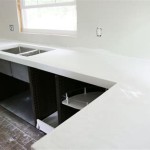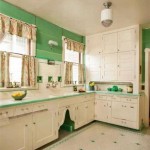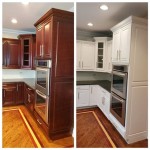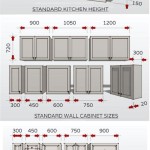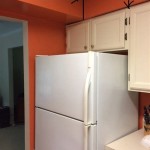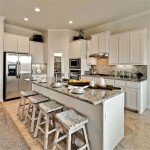Angled Kitchen Cabinets: Design, Functionality, and Installation
Angled kitchen cabinets represent a specialized design approach in kitchen cabinetry, deviating from the standard rectangular or square configurations. These cabinets feature one or more sides that are not perpendicular to the adjacent walls or cabinets, creating angles that can serve both aesthetic and functional purposes. This design choice can significantly impact the overall layout and flow of a kitchen, offering unique storage solutions and visual interest.
The use of angled cabinets is not a new concept, but its application has become increasingly sophisticated with advancements in cabinet manufacturing and design software. Contemporary kitchens often incorporate angled cabinets to maximize space utilization in irregularly shaped rooms, to break up monotonous lines in larger kitchens, or to create focal points that draw the eye. They can be integrated into various kitchen styles, from traditional to modern, depending on the materials, finishes, and hardware chosen.
The installation of angled cabinets requires meticulous planning and execution due to their non-standard dimensions and angles. Accurate measurements and precise alignment are crucial to ensure a seamless and functional end result. This article will delve into the design considerations, functionality, and installation process associated with angled kitchen cabinets.
Design Considerations for Angled Kitchen Cabinets
Designing with angled kitchen cabinets necessitates a comprehensive understanding of space planning and design principles. The angle itself is a critical factor, as it determines the cabinet's internal volume and the ergonomic accessibility of stored items. Steeper angles may result in smaller storage spaces, while shallower angles can create wider, more accessible shelves.
The surrounding elements, such as appliances, countertops, and other cabinets, must also be carefully considered. The angle of the cabinet should complement the overall layout and not obstruct walkways or create awkward transitions. In corner areas, angled cabinets can effectively bridge two intersecting walls, maximizing the use of otherwise difficult-to-access space.
Material selection plays a significant role in the aesthetic impact of angled cabinets. The chosen material should be durable and suitable for the kitchen environment. Solid wood, plywood, and MDF (Medium Density Fiberboard) are commonly used for cabinet construction, each offering different properties in terms of strength, moisture resistance, and cost. The finish of the cabinets, whether painted, stained, or laminated, should also be selected to harmonize with the overall kitchen décor.
Hardware choices, including knobs, pulls, and hinges, can further enhance the functionality and appearance of angled cabinets. Soft-close hinges are particularly beneficial for cabinets with unconventional angles, as they prevent slamming and ensure smooth, controlled closing. The style and finish of the hardware should complement the cabinet's design and the overall kitchen aesthetic. Internal organization, which includes pull-out shelves, lazy susans, and customized dividers, is essential to maximize the usability of angled cabinets. This is especially important due to the potentially irregular shapes and depths created by the angled design.
Lighting should be factored into the design. Under-cabinet lighting can highlight the unique shape and texture of angled cabinets, adding visual appeal and functionality to the workspace. Task lighting should be positioned to illuminate the countertop and work areas effectively, minimizing shadows and ensuring adequate visibility.
Ergonomics are also paramount. The height and depth of angled cabinets should be tailored to the user's needs and preferences. Cabinets positioned too high or too low can strain the back and neck. Similarly, cabinets that are too deep can make it difficult to reach items stored at the back. Planning for universal design principles, such as varying counter heights and accessible storage, can make the kitchen more user-friendly for individuals with diverse needs and abilities.
Functionality and Space Optimization
The primary advantage of angled kitchen cabinets lies in their ability to optimize space utilization, especially in kitchens with irregular shapes or limited square footage. They can effectively fill corners and create seamless transitions between different sections of the kitchen, maximizing storage capacity and workflow efficiency.
In corner areas, angled cabinets can replace traditional blind corner cabinets, which often suffer from limited accessibility and wasted space. By angling the cabinet, the interior becomes more accessible, and items stored inside can be easily retrieved. The angled configuration also provides a wider opening, allowing for easier access to larger items.
Angled cabinets can also serve as focal points in the kitchen, drawing the eye and adding visual interest. They can be used to create a unique design feature, such as a display cabinet for showcasing decorative items or a beverage center with a built-in wine rack. The angled shape can also be used to break up long runs of cabinets, adding depth and dimension to the kitchen design.
The design of angled cabinets can be customized to suit specific storage needs. Tall angled pantry cabinets can provide ample storage for dry goods and kitchen supplies. Angled base cabinets can be used to store pots, pans, and other cooking equipment. The internal configuration of the cabinets can be further customized with pull-out shelves, dividers, and other accessories to maximize storage efficiency.
The integration of appliances into angled cabinets requires careful planning. Dishwashers, refrigerators, and ovens must be positioned to allow for proper ventilation and accessibility. The angle of the cabinet should not obstruct the appliance's door or hinder its operation. Custom panels can be used to conceal appliances and create a seamless, integrated look.
Furthermore, angled islands can be created using angled cabinets. These islands add counter space, storage, and a gathering spot in the kitchen. The angled configuration can facilitate better traffic flow around the island and provide a more ergonomic workspace. The design of the angled island should complement the rest of the kitchen and reflect the overall design aesthetic.
Installation Process of Angled Kitchen Cabinets
The installation of angled kitchen cabinets requires a higher level of precision and skill than that of standard rectangular cabinets. Accurate measurements, precise alignment, and careful attention to detail are essential to ensure a successful installation.
The first step in the installation process is to precisely measure the space where the angled cabinets will be installed. The angles of the walls and the dimensions of the surrounding elements must be accurately recorded. These measurements will be used to determine the exact dimensions of the cabinets and to ensure a proper fit.
Before installing the cabinets, it is important to prepare the walls. The walls should be level, plumb, and free of any obstructions. Any necessary plumbing or electrical work should be completed before the cabinets are installed. Wall studs should be located and marked to provide secure attachment points for the cabinets.
The installation typically begins with the base cabinets. The cabinets should be positioned according to the design plan and leveled using shims. The cabinets should then be secured to the wall studs using screws. Ensure the cabinets are aligned correctly and that the angles match the design specifications. Clamps can be used to hold the cabinets in place while the screws are being driven in.
Once the base cabinets are installed, the wall cabinets can be installed. The wall cabinets should be hung using a rail system or directly attached to the wall studs. Ensure the cabinets are level and aligned with the base cabinets. The distance between the base and wall cabinets should be consistent and in accordance with the design plan.
After the cabinets are installed, the countertops can be installed. The countertops should be custom-cut to fit the angled cabinets. The edges of the countertops should be finished to match the cabinet design. Seams between countertop sections should be carefully sealed to prevent water damage.
The final step is to install the hardware, including knobs, pulls, and hinges. The hardware should be installed according to the manufacturer's instructions. Adjust the hinges to ensure the doors and drawers open and close smoothly. Inspect the installation carefully to ensure that all cabinets are level, aligned, and securely attached. Make any necessary adjustments to correct imperfections.
Properly installed angled cabinets can significantly enhance the aesthetic appeal and functionality of a kitchen. The meticulous planning and execution required for successful installation demonstrate the importance of professional craftsmanship. The unique design opportunities presented by angled cabinets allow for personalized kitchen designs that optimize space utilization and reflect individual style preferences.

13 Angled Cabinet Ideas Kitchen Design Cabinets

I Need Your Advice Kitchen Corner Cabinets My Uncommon Slice Of Suburbia

Before And After Elegant Kitchen Makeover Remodel Layout Small White Remodeling

13 Angled Cabinet Ideas Kitchen Design Cabinets

Angled Corner Cabinets Photos Ideas Houzz

My Scandinavian Home A White Swedish With An Angled Kitchen

Airy Auchenflower Angled Kitchen Kbk Kitchens

Make The Most Of Those Corner Kitchen Cabinets

Optimizing Blind Corner Cabinets American Wood Reface

Angled Kitchen Cabinets With Brass Hardware Cottage
Related Posts

